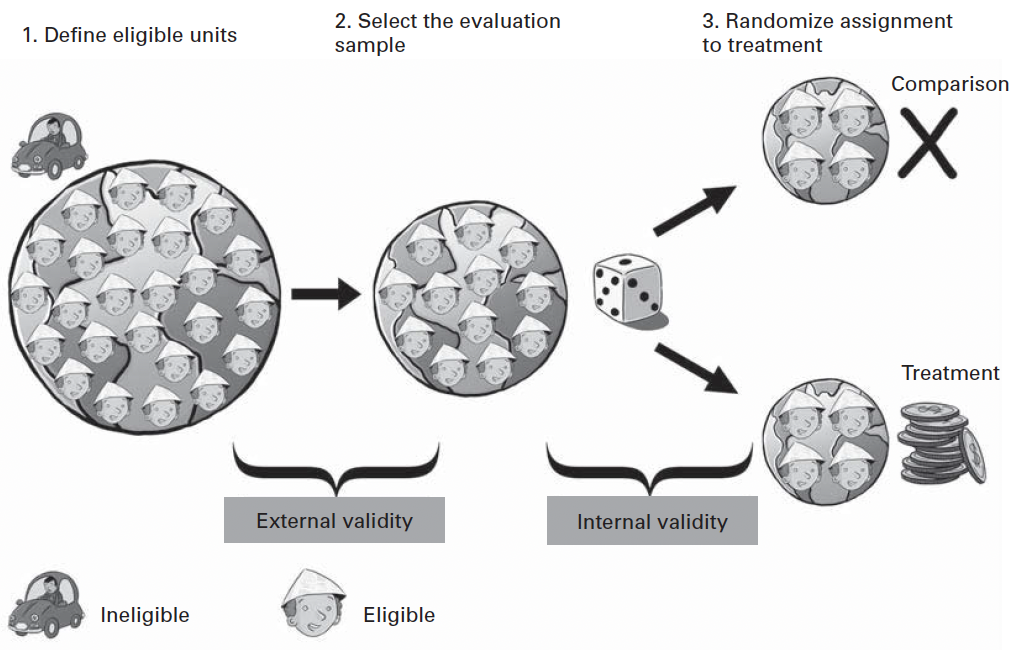Lecture 5 Evaluation Designs
April 13, 2024
Recap lecture 4
- Stakeholders
- Identify key stakeholder
- Engaging stakeholders
- ARPR-E case
- Review of logic models and preliminary discussion of student project ideas
Today’s agenda
- Evaluation design
- RCT
- Other strategies
- Proposal
- Progress on evaluation project
Evaluation designs
- Experimental
- Randomised controled trial
- Quasi-experimental
- Regression discontinuity
- Difference in differences
- Observational (Non-experimental)
- Time–series analysis (Pre- and post-intervention studies)
- Cross-sectional surveys
- Case studies
Counterfactural: What if?
What would have happened in the absence of the program?
How do we measure what would have happened if the other circumstance had prevailed?
Comparison group
A valid comparison group:
- has the same characteristics, on average, as the treatment group in the absence of the program;
- remains unaffected by the program; and
- would react to the program in the same way as the treatment group, if given the program.
Note: Individual level effect is impossible to observe. No individual counterfactuals.
Source: Gertler et al. (2016)
Naive design
- Naturally occurring treated and untreated groups
- Examples
- Students who participated pre-K (test scores)
- Moms who use anesthetic (hospital stays)
- Questions to ask: Do we expect that if the program had not been offered, the outcomes of the treated and untreated comparison groups would have been roughly the same?
Challenges
- Self-selection
- Selection bias
The power of randomized
Comparing average outcomes only works if groups that received/didn’t receive treatment look the same.

Source: Gertler et al. (2016)
Random assignment methods
- Coins
- Dice
- Lottery
- Random numbers
Tool: Random Generator
Steps in RCTs

Source: Gertler et al. (2016)
What can be randomized?
Different ways to randomize come from three basic elements of a program which can be randomized
Access: which people are offered access to a program
Timing: when people are offered access
Encouragement: which people are given encouragement to participate
Source: ECMA 35550
When to use RCTs?
- Demand for treatment exceeds supply
- Treatment will be phased in over time
- Treatment has uncertainty
- Local culture open to randomization
- When people won’t know and it’s ethical
- When lotteries are going to happen anyway
When not?
- When you need immediate results
- When it’s unethical or illegal
- When it’s something that happened in the past
- When it involves universal ongoing phenomena
Abdul Latif Jameel Poverty Action Lab

Source: J-PAL
Quasi experiment design
Not randomized assignments
- Regression discontinuity design (RDD)
- Difference in differences (DiD)
- Other designs
Regression discontinuity design (RDD)
Programs that have a continuous eligibility index with a clearly defined eligibility threshold (cutoff score) to determine who is eligible and who is not.
- The index must rank people or units in a continuous or “smooth” way.
- The index must have a clearly defined cutoff score.
- The cutoff must be unique to the program of interest.
- The score of a particular individual or unit cannot be manipulated.
Difference in differences (DiD)
Compares the changes in outcomes over time between a population that is enrolled in a program (the treatment group) and a population that is not (the comparison group).

Rule of thumb
- Correlation is the beginning of understanding what happens to a group
- Correlation does not equal causation
- Evaluation design will depends on possibility, feasibility, and appropriability